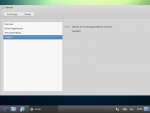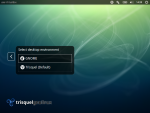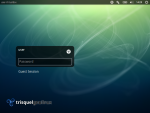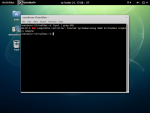New to Trisquel - No Gnome panel
- Vous devez vous identifier ou créer un compte pour écrire des commentaires
Hello,
I was recently introduced to GNU/Linux and FSF and decided to try Trisquel.
I installed it first on my MacBook (2008) and it looked fine, and I decided to install it on my MacBook Pro retina (2012). Installation was fine, but when I log in the Gnome Panel is not visible (and no date/time at the top either).
I searched the Trisquel site and found this, which is my problem exactly:
https://trisquel.info/en/issues/16525
Being totally new here, I don't know to proceed. Was it logged as a bug, and is it possible to see progression or solution somewhere?
Thanks!
If you create a new user account (from "User Accounts" in the "System Settings"), does it suffer from the same problem? Alt+F1 should show you the menu despite the absence of a panel.
Another "solution" is to use another desktop environment. GNOME Shell for instance (search the eponymous package in Trisquel's repository).
Thanks for suggestions.
I tried Guest session and a new user. Looks the same - no panel.
I used Synaptic Package handler and searched for gnome shell. gnome-shell-common was already installed. I installed gnome-shell and restarted, but can see no difference.
Should I install gnome (says Full GNOME desktop in description)? Do I need to uninstall the current, standard desktop environment?
My guess is that the panel is in place and working, but Trisquel cannot show the whole desktop, and it is not possible to scroll. With other resolutions, Trisquel does not scale the desktop, but shows smaller parts of it magnified. No scrolling is possible. The retina resolution is 2880 x 1800.
Is it possible to see what graphic card and driver Trisquel uses?
You can see the driver in System Settings --> Details.
If you installed Gnome Shell, you'll see a new option on the login screen. It's behind the Trisquel next to your user name.



Thanks! I make progress!
Driver is Gallium 0.4 on NVE7. I don't know what that means though, or which of the to graphics cards that it drives.
And now I was able to find and start the GNOME shell! (Text on my login screen is extremely tiny, would never have found it without help).
My GNOME Shell shows a panel on the top, but nothing at the bottom. Is that correct?
Top left has a button for Activities, which has the same function as alt+F1 now. With mouse to the bottom, a bar for notifications emerges.
I miss the Start-button like menu in standard Trisquel. Perhaps I need to install the gnome package also? (Full GNOME desktop that description said.)
Gallium is a free driver. NVidia's own driver is proprietary, so Trisquel won't offer or suggest it. It probably takes advantage of the integrated GPU only if any.
Check your graphics card on the command line (paste this into your terminal).
lspci|grep VGA
Gnome 3 has by default only one panel at the top. You can install extensions and have an application menu and many more tweaks. Just open Gnome Tweak Tool (press on Super/Windows key/Command key and start writing Tw..).
Nvidia it is.
I have to test some of the extensions to see if any of them suits me.
Perhaps the old fruit's machines are not the best to start a free software career from.
Thanks again!
I would first advise you to read https://wiki.gnome.org/Projects/GnomeShell/CheatSheet and discover useful shortcuts.
Then see http://extensions.gnome.org for extensions to GNOME Shell. Those extensions can completely modify the interface. GNOME Classic actually is a set of extensions that turns GNOME Shell into a classical desktop (similar to GNOME 2). I think the package "gnome-shell-extensions" (in Trisquel's repository) contains them all, i.e., you need not visit http://extensions.gnome.org to have GNOME Classic. You can use the "Extensions" tab of "Tweak Tool" in the "System Settings" to activate/deactivate/configure an extension.
And, sure, there are other desktop environments in Trisquel's repository: LXDE, Xfce, KDE, etc.
Thanks all!
I've been away, but now installed both gnome-shell-extensions and XFCE and very short tried both. I find GNOME Classic very nice indeed. XFCE seems also very good, but everything is really tiny. I presume the others handles the resolution (2880x1800) by scaling up? I haven't found a setting for that in XFCE. Lower resolution is possible, but loses sharpness. What can I do?
- Vous devez vous identifier ou créer un compte pour écrire des commentaires








